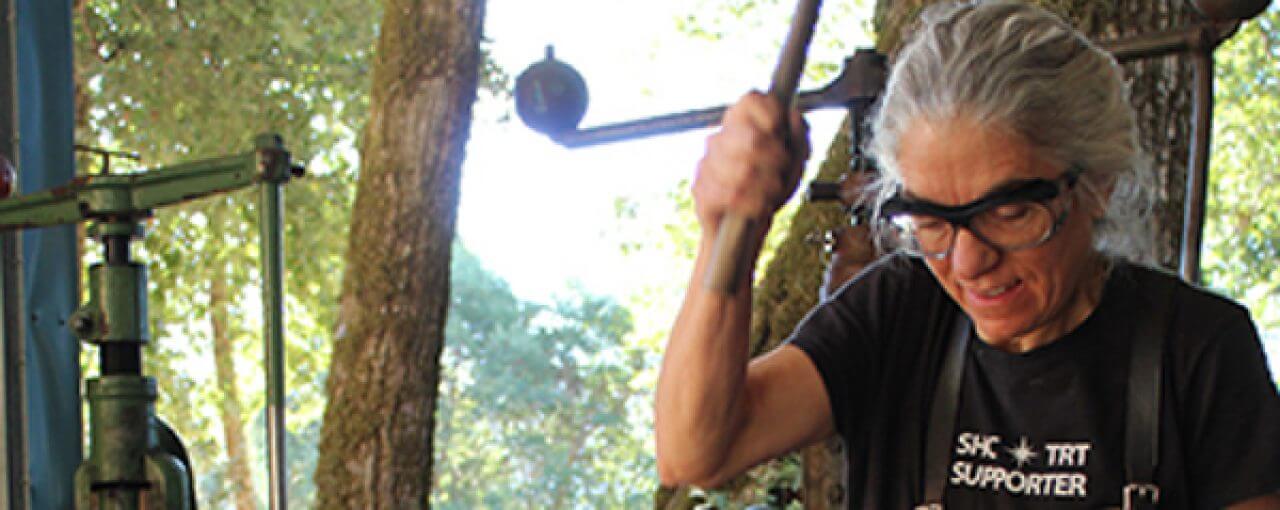See Coyne’s work in WTP Vol. VI #8
Inside the Studio offers a behind-the scenes peek into the work environments of WTP artists, as well as insight into their creative process within these resonate spaces.
By Jennifer Nelson, WTP Feature Writer
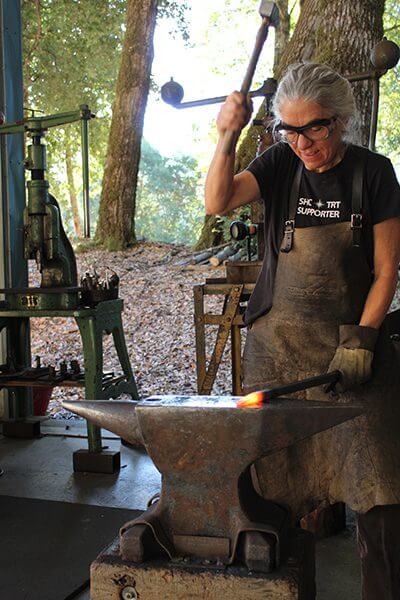
Metal sculptor Monica Coyne is inspired by the rainforest surrounding her forge shop, a forty-minute drive from the nearest town in Humboldt County, California. Every day, she opens two roll-up doors, onto a view of mature madrones and towering firs. It doesn’t matter if it’s raining—that area averages eighty inches of rain in winter—or hot as in summer when temperatures climb to 105 degrees: “The rain, the fog, and the crisp crackling leaves at the height of the dry summer fill my brain with thoughts about our connection to everything,” says Coyne. “Transferring these thoughts to cold, black, industrially manufactured steel creates a fascinating dichotomy. This drives my work.”
She works in a thirty-by-forty-foot steel building a hundred yards from her house. Ten years ago, she and her husband hired a crew to install the prefabricated building on a slab they’d poured. This was her first studio. Before that, she worked in a fabrication shop where she produced her gates and railings.
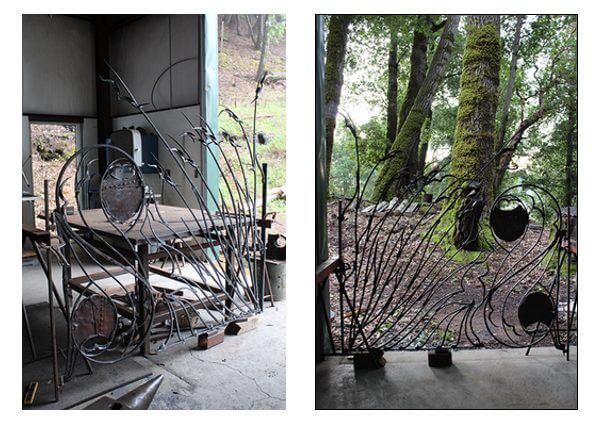
When people first visit her shop, they hesitate before entering, daunted by multiple machines, as well as Coyne in her thick pigskin apron, stained black with coal dust, rust, and oil. Her apron shields her from hot metal, scale, and flying wire brush fragments, leaving behind burned lines and shapes. She finds incredible beauty in forging, as it turns the shop into pixels of metal dust. “The smoke of a freshly-lit fire curls up into ghosts and dragons that then get sucked up the flue,” she says.
Coyne and her husband generate all their own electricity—the nearest public utility is two miles away. During the summer, their electricity comes from solar power, and in the winter, hydropower. They depend on a 25-kilowatt-diesel generator for backup between seasons or when she uses a welder or plasma cutter. The generator runs less than 150 hours annually. She uses batteries to store excess solar and hydropower that she taps during times with no sun or rain. “All of my fans, blowers, forgers, lights and small power tools run without the generator,” she says. “Most of the time, my shop is run with renewable power.”
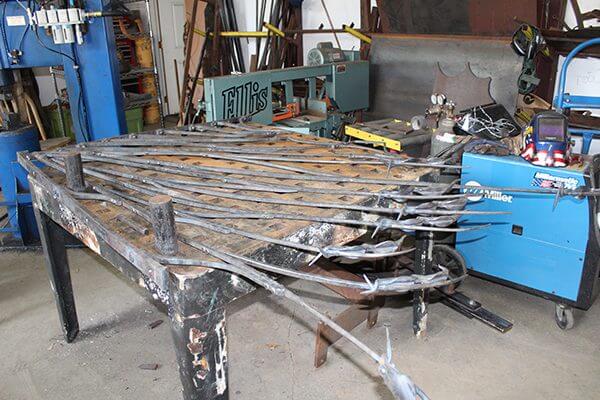
Being off the grid doesn’t change how she and her husband do things. They have typical household appliances and a well-stocked metal shop. Nevertheless, they are aware of how much electricity they consume, and they never leave a light on. “You would be surprised at how normal we live,” she says.
Blacksmithing requires heating materials to extremely high temperatures, with either a small propane forge, coal forge, or an oxygen/propane torch. To reach high temperatures, pure oxygen is needed. Since oxygen tanks are expensive and hard to come by—the nearest place to buy one is a two-hour drive away—Coyne makes oxygen using excess power from her solar and hydro systems.
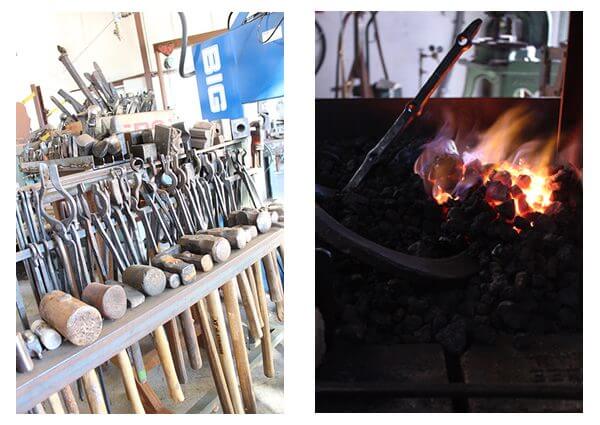
Her workspace is big enough to handle creating big installations, and she built herself a gantry crane to move heavy, large pieces around her shop. Though she has worked with bronze and copper, her favorite materials are steel and wrought iron, which she gets from steel and scrap yards. Wrought iron has the advantage of being relatively soft: “A found piece of wrought iron can have very different properties. It can offer an incredibly varied grain pattern, which can add an interesting texture to the piece.”
Coyne has focused most of her career on making commissioned pieces. Almost every project involves making a new tool, from hammer and tongs to chisels, fullers, bolsters, swages, and drifts. “Tools are your fingers when you are forging. Forging steel is like forming clay, but the medium is 2,000 degrees and incredibly tough.”
Her workshop boasts a solid, flat anvil, a layout table, and a small pneumatic power hammer called a Big Blu, which moves material quickly and acts as a mechanical striker. Two fly presses use no power, but increase her physical strength to eight tons. “They are amazing antique tools.”
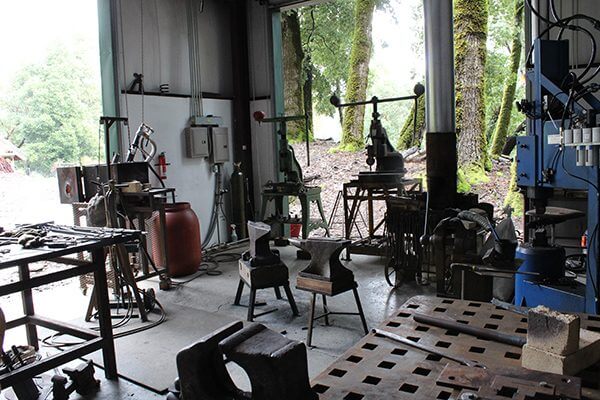
She arrives at her forge shop between 7 and 8 a.m., takes a lunch break, and works until 5 or 6 p.m. She focuses on one project at a time, methodically planning on a calendar its needs and timing. A project progresses through the following phases: design/drawing, tooling, process, assembly, and finish. She allows time for research and development when creating with a new form. She spends five full days in her shop. If her day gets cut short by other business needs such as preparing or traveling for demonstrations, she makes up the time on weekends. “Forging steel is highly labor intensive,” she says. “I am not a big person or a young one. I take advantage through time well spent.”
Coyne sees unlimited options when teaming up with other skilled blacksmiths. She herself has collaborated with blacksmiths on making two benches and giving demonstrations. “Working with others gives you exposure to how other people think,” she says. “This is helpful when returning to my shop. It opens my eyes to other options for completing tasks.”

In the blacksmithing community, Coyne made a name for herself by forging forms that contradict the material’s weight and the craft’s prudential practice. Steel’s strength allows her to experiment with balance and symmetry and its versatility, to create surprising forms. She uses “parent stock,” a manufactured bar from the steel mill. “Living in this natural environment, I became obsessed with the question of how we relate to this parent stock. I began to research how humans got from smelting iron ore to industrial steelmaking. These connections, these questions have pushed me to make sculpture.”
By winning the 2018 Victor Jacoby Award, Coyne can now focus more on sculpture. “I am using traditional blacksmithing technique and tooling to create a form that tricks your brain into seeing a person,” she says. “A person born from this parent stock.”
Copyright 2018 Woven Tale Press LLC. All Rights Reserved.

